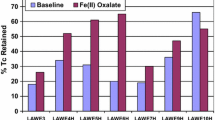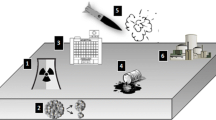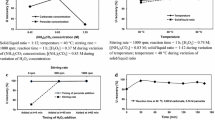Abstract
Technetium-99 and cesium-137 are two radionuclides in high level waste (HLW) that can volatilize from high temperature melters during the immobilization of the HLW into a borosilicate glass. At Savannah River Site (SRS) we have obtained data that indicate that this volatilization is small from the full scale production melter in the Defense Waste Processing Facility (DWPF). These data were obtained during the vitrification of the first HLW macrobatch at SRS. This campaign lasted ~2.5 years and produced ~9 hundred metric tons of glass from ~1.6 million liters of HLW. Losses of Tc-99 and Cs-137 were determined by comparing their measured concentrations in the glass with their respective predicted concentrations based on the composition of the HLW being vitrified. For three glass samples taken during the campaign, the measured and predicted concentrations agreed within 7% or better indicating a small loss of either radionuclide. The DWPF melter operates with a cold cap on the surface of the melt. This cold cap could enhance the radionuclide retention, especially Tc-99.
Similar content being viewed by others
References
J. A. Rard, Critical Review of the Chemistry and Thermodynamics of Technetium and Some of Its Inorganic Compounds and Aqueous Species, UCRL-53440, Lawrence Livermore National Laboratory, Livermore, CA, 1983.
J. Vida, The Chemical Behavior of Technetium During the Treatment of High-Level Radioactive Waste, KfK 4642, Translated by J. R. Jewett, PNL-TR-497, Westinghouse Hanford Co., 6/23/ 1994.
H. Lammertz, E. Merz, and ST. Halaszovich, Technetium Volatilization during HLL W Vitrification, Scientific Basis for Nuclear Waste Management VIII, Mat. Res. Soc. Symp. Vol 44, p. 823, Materials Research Society, Pittsburgh, PA, 1985.
G.L. Smith, Characterization of Analytical Reference Glass 1 (ARG-1), PNNL-8992, Pacific Northwest Laboratory Report, (1993).
N.E. Bibler, W.F. Kinard, W. T. Boyce, and C.J. Coleman, J. Radioanal. Nucl. Chem., 234, p. 159–163 (1998).
N. E. Bibler, J. W. Ray, T. L. Fellinger, O. B. Hodoh, R. S. Beck, and O. G. Lien, Characterization of the Radioactive Glass Currently Being Produced by the Defense Waste Processing Facility at the Savannah River Site, Proceedings - Waste Management ’98, CD-ROM Session 14 (1998).
M. K. Andrews and N. E. Bibler, Ceramic Transactions, 39, The American Ceramic Soc., Westerville, OH, 1994, p. 205.
Author information
Authors and Affiliations
Rights and permissions
About this article
Cite this article
Bibler, N.E., Fellinger, T.L., Marra, S.L. et al. Tc-99 and Cs-137 Volatility from the DWPF Production Melter During Vitrification of the First Macrobatch of HLW Sludge at the Savannah River Site. MRS Online Proceedings Library 608, 697 (1999). https://doi.org/10.1557/PROC-608-697
Published:
DOI: https://doi.org/10.1557/PROC-608-697




